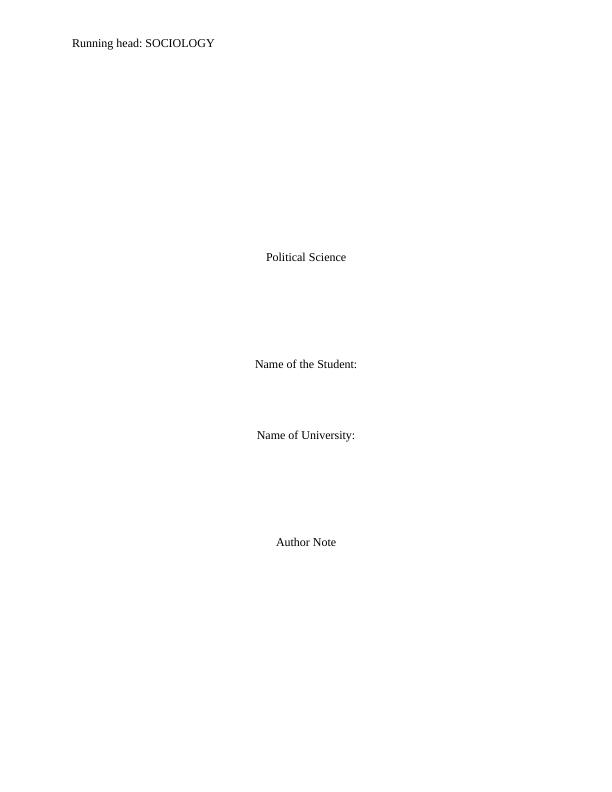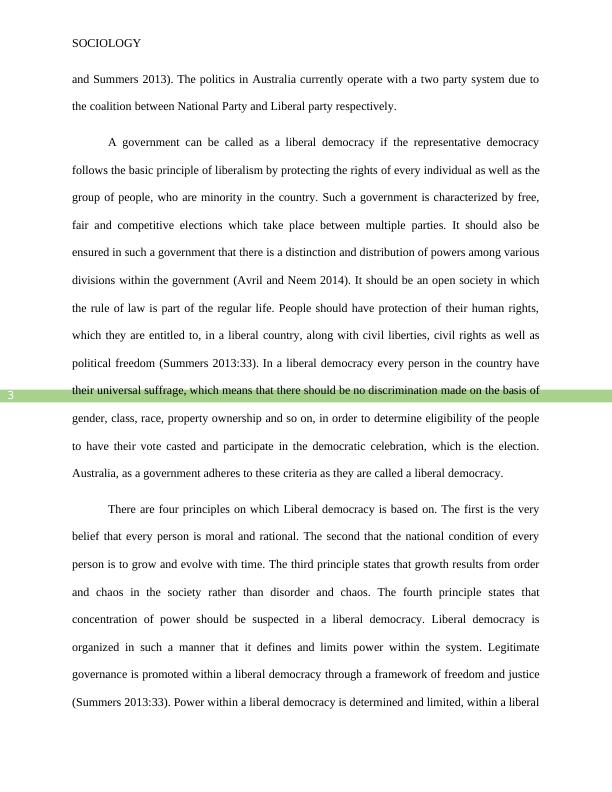Australia has a representative democracy
Added on 2022-07-28
6 Pages1622 Words26 Views
Running head: SOCIOLOGY
Political Science
Name of the Student:
Name of University:
Author Note
Political Science
Name of the Student:
Name of University:
Author Note

2
SOCIOLOGY
Australia has a representative democracy in which people who are eligible cast their
votes in favor of the candidates of their choice who represent the people and govern on the
behalf of people. Australian system of the government is a blend of some traditions native to
North America on one hand while British Government on the other hand. The Australian
democracy, thus has a unique structure and functionality of its own. It is quite exceptional that
the Australian politics have a framework in which there are constitutional monarchy as well as a
federal constitutional parliamentary democracy (Jones 2014). Australia operates through a two
party system in which, voting is the basic criteria through which people participate in the
democracy. The thesis of the paper is to analyze Australian Politics and government.
The federal parliament of Australia is run by parliamentarians who are elected by the
Australians and an amalgamation of some elements of executive which have been adopted from
the Westminster system along with a federalist senate which have been inherited from America.
The political landscape of Australia is dominated by the national parties since the very beginning
of the federation in the country (Fenna, Robbins and Summers 2013). During the nineteenth
century, the Australian Labor party became prominent in the country as they represented the
labor class within the country. There were two prominent parties which opposed the Australian
Labor party which are the Liberal Party of Australia and National Party of Australia. The Liberal
Party primarily are represented by the business and middle class people of the country who offer
a social conservative approach to the politics while the National Party represent the agrarian or
the rural. There also exist some other parties which have been able to gain very little prominence
and parliamentary representation, whereas the political scenario in Australia is heavily
dominated by the three national parties who organize the politics in the country (Fenna, Robbins
SOCIOLOGY
Australia has a representative democracy in which people who are eligible cast their
votes in favor of the candidates of their choice who represent the people and govern on the
behalf of people. Australian system of the government is a blend of some traditions native to
North America on one hand while British Government on the other hand. The Australian
democracy, thus has a unique structure and functionality of its own. It is quite exceptional that
the Australian politics have a framework in which there are constitutional monarchy as well as a
federal constitutional parliamentary democracy (Jones 2014). Australia operates through a two
party system in which, voting is the basic criteria through which people participate in the
democracy. The thesis of the paper is to analyze Australian Politics and government.
The federal parliament of Australia is run by parliamentarians who are elected by the
Australians and an amalgamation of some elements of executive which have been adopted from
the Westminster system along with a federalist senate which have been inherited from America.
The political landscape of Australia is dominated by the national parties since the very beginning
of the federation in the country (Fenna, Robbins and Summers 2013). During the nineteenth
century, the Australian Labor party became prominent in the country as they represented the
labor class within the country. There were two prominent parties which opposed the Australian
Labor party which are the Liberal Party of Australia and National Party of Australia. The Liberal
Party primarily are represented by the business and middle class people of the country who offer
a social conservative approach to the politics while the National Party represent the agrarian or
the rural. There also exist some other parties which have been able to gain very little prominence
and parliamentary representation, whereas the political scenario in Australia is heavily
dominated by the three national parties who organize the politics in the country (Fenna, Robbins

3
SOCIOLOGY
and Summers 2013). The politics in Australia currently operate with a two party system due to
the coalition between National Party and Liberal party respectively.
A government can be called as a liberal democracy if the representative democracy
follows the basic principle of liberalism by protecting the rights of every individual as well as the
group of people, who are minority in the country. Such a government is characterized by free,
fair and competitive elections which take place between multiple parties. It should also be
ensured in such a government that there is a distinction and distribution of powers among various
divisions within the government (Avril and Neem 2014). It should be an open society in which
the rule of law is part of the regular life. People should have protection of their human rights,
which they are entitled to, in a liberal country, along with civil liberties, civil rights as well as
political freedom (Summers 2013:33). In a liberal democracy every person in the country have
their universal suffrage, which means that there should be no discrimination made on the basis of
gender, class, race, property ownership and so on, in order to determine eligibility of the people
to have their vote casted and participate in the democratic celebration, which is the election.
Australia, as a government adheres to these criteria as they are called a liberal democracy.
There are four principles on which Liberal democracy is based on. The first is the very
belief that every person is moral and rational. The second that the national condition of every
person is to grow and evolve with time. The third principle states that growth results from order
and chaos in the society rather than disorder and chaos. The fourth principle states that
concentration of power should be suspected in a liberal democracy. Liberal democracy is
organized in such a manner that it defines and limits power within the system. Legitimate
governance is promoted within a liberal democracy through a framework of freedom and justice
(Summers 2013:33). Power within a liberal democracy is determined and limited, within a liberal
SOCIOLOGY
and Summers 2013). The politics in Australia currently operate with a two party system due to
the coalition between National Party and Liberal party respectively.
A government can be called as a liberal democracy if the representative democracy
follows the basic principle of liberalism by protecting the rights of every individual as well as the
group of people, who are minority in the country. Such a government is characterized by free,
fair and competitive elections which take place between multiple parties. It should also be
ensured in such a government that there is a distinction and distribution of powers among various
divisions within the government (Avril and Neem 2014). It should be an open society in which
the rule of law is part of the regular life. People should have protection of their human rights,
which they are entitled to, in a liberal country, along with civil liberties, civil rights as well as
political freedom (Summers 2013:33). In a liberal democracy every person in the country have
their universal suffrage, which means that there should be no discrimination made on the basis of
gender, class, race, property ownership and so on, in order to determine eligibility of the people
to have their vote casted and participate in the democratic celebration, which is the election.
Australia, as a government adheres to these criteria as they are called a liberal democracy.
There are four principles on which Liberal democracy is based on. The first is the very
belief that every person is moral and rational. The second that the national condition of every
person is to grow and evolve with time. The third principle states that growth results from order
and chaos in the society rather than disorder and chaos. The fourth principle states that
concentration of power should be suspected in a liberal democracy. Liberal democracy is
organized in such a manner that it defines and limits power within the system. Legitimate
governance is promoted within a liberal democracy through a framework of freedom and justice
(Summers 2013:33). Power within a liberal democracy is determined and limited, within a liberal

End of preview
Want to access all the pages? Upload your documents or become a member.
Related Documents
Structure and Role of the Australian Parliamentary Systemlg...
|8
|1692
|330
The Importance of a Two Party System in Australian Liberal Democracylg...
|7
|2057
|63
Australia’s Liberal Democratic System (Doc)lg...
|6
|1655
|533
Minor Parties in Australian Governmentlg...
|8
|1789
|76
Australian Political Systemlg...
|9
|2617
|248
Australian Political System - Essaylg...
|10
|2782
|34
